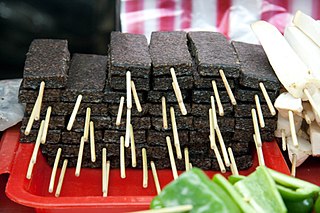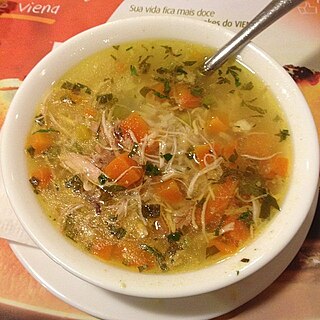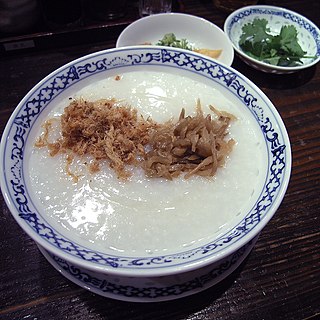Canja de Goa (Goan soup) is a typical soup of the Indo-Portuguese cuisine of Goa, Daman and Diu, which once formed part of the Portuguese India, and is inspired by Portuguese soup. [1]
It is prepared with chicken, local sausage, onion, garlic, rice, water and salt. All these ingredients are cooked together in a saucepan or in a pressure cooker. Finally, extract of chicken bones is added. [1]
According to tradition, in Goa, it was made for women who gave birth in the family home. After the first birth, the mothers-in-law sent to the brides a bottle of port wine and six chickens, to be used in preparing the soup, since this was considered a good food for mothers and convalescents. [1]
It is consumed around 11 am, together with curry from the previous day, sweet mango chutney and salted fish. Sometimes it is transported to the fields by children, in a vessel of clay, for their parents and older siblings working there. [1]

Chicken soup is a soup made from chicken, simmered in water, usually with various other ingredients. The classic chicken soup consists of a clear chicken broth, often with pieces of chicken or vegetables; common additions are pasta, noodles, dumplings, or grains such as rice and barley. Chicken soup has acquired the reputation of a folk remedy for colds and influenza, and in many countries is considered a comfort food.

Offal, also called variety meats, pluck or organ meats, is the internal organs of a butchered animal. The word does not refer to a particular list of edible organs, and these lists of organs vary with culture and region, but usually exclude skeletal muscle. Offal may also refer to the by-products of milled grains, such as corn or wheat.

Trinidad and Tobago has a unique history and its food is influenced by Indian-South Asian, West African, Creole, European, American, Chinese, Amerindian, and Latin American culinary styles. Trinidad and Tobagonian food is dominated by a wide selection of seafood dishes, most notably, curried crab and dumplings. Trinidad and Tobago is also known for its prepared provisions, such as dasheen, sweet potato, eddoe, cassava, yam, soups and stews, also known as blue food across the country. Corresponding to the Blue Food Day event held annually in Trinidad and Tobago.

The oldest known book on Portuguese cuisine, entitled Livro de Cozinha da Infanta D. Maria de Portugal, from the 16th century, describes many popular dishes of meat, fish, poultry and others.

Singaporean cuisine is derived from several ethnic groups in Singapore and has developed through centuries of political, economic, and social changes in the cosmopolitan city-state.

Sopa de mondongo is a soup made from diced tripe slow-cooked with vegetables such as bell peppers, onions, carrots, cabbage, celery, tomatoes, cilantro, garlic or root vegetables. The dish is generally prepared in former Spanish colonies in Latin America, Caribbean, and in the Philippines.

Chicken feet are cooked and eaten in many countries. After an outer layer of hard skin is removed, most of the edible tissue on the feet consists of skin and tendons, with no muscle. This gives the feet a distinct gelatinous texture different from the rest of the chicken meat.

Caldo de pollo is a common Latin American soup that consists of chicken and vegetables.

Blood as food is the usage of blood on food, religiously and culturally. Many cultures consume blood, often in combination with meat. The blood may be in the form of blood sausage, as a thickener for sauces, a cured salted form for times of food scarcity, or in a blood soup. This is a product from domesticated animals, obtained at a place and time where the blood can run into a container and be swiftly consumed or processed. In many cultures, the animal is slaughtered. In some cultures, blood is a taboo food.
Goan cuisine consists of regional foods popular in Goa, an Indian state located along India's west coast on the shore of the Arabian Sea. Rice, seafood, coconut, vegetables, meat, bread, pork and local spices are some of the main ingredients in Goan cuisine. Use of kokum and vinegar is another distinct feature. Goan food is considered incomplete without fish.

The Mangalorean Catholic Cuisine is the cuisine of the Mangalorean Catholic community.

Soup is a primarily liquid food, generally served warm or hot, that is made by combining ingredients of meat or vegetables with stock, milk, or water. Hot soups are additionally characterized by boiling solid ingredients in liquids in a pot until the flavors are extracted, forming a broth. Soups are similar to stews, and in some cases there may not be a clear distinction between the two; however, soups generally have more liquid (broth) than stews.

Canja de galinha, or simply canja, is a popular chicken soup of Portuguese, Cape Verdean, and Brazilian cuisine. The Portuguese term galinha literally means "hen", but became the generic name for the species, much like chicken in English. Portuguese chicken congee has the rice much more cooked than in most Western chicken soup recipes, but it is not disintegrated as in the Asian one.

Bissau-Guinean cuisine is the food culture of Guinea-Bissau, a nation on Africa's west coast along the Atlantic Ocean. Rice is a staple in the diet of residents near the coast and millet a staple in the interior. Much of the rice is imported and food insecurity is a problem in large part due to coups, corruption and inflation. Cashews are grown for export. Coconut, palm nut, and olives are also grown.

Congee or conjee is a type of mostly savoury rice porridge or gruel of Asian origin. It can be eaten plain, where it is typically served with side dishes, or it can be served with ingredients such as meat, fish, seasonings and flavourings, most often savory, but sometimes sweet. It is typically served as a meal on its own, especially for breakfast or people who are ill. Names for congee are as varied as the style of its preparation, but all are made with rice cooked as a softened porridge with a larger quantity of water than other types of cooked rice like pilaf or claypot rice.

Ashkenazi Jewish cuisine is an assortment of cooking traditions that was developed by the Ashkenazi Jews of Central, Eastern and Northern Europe, and their descendants, particularly in the United States and other Western countries.